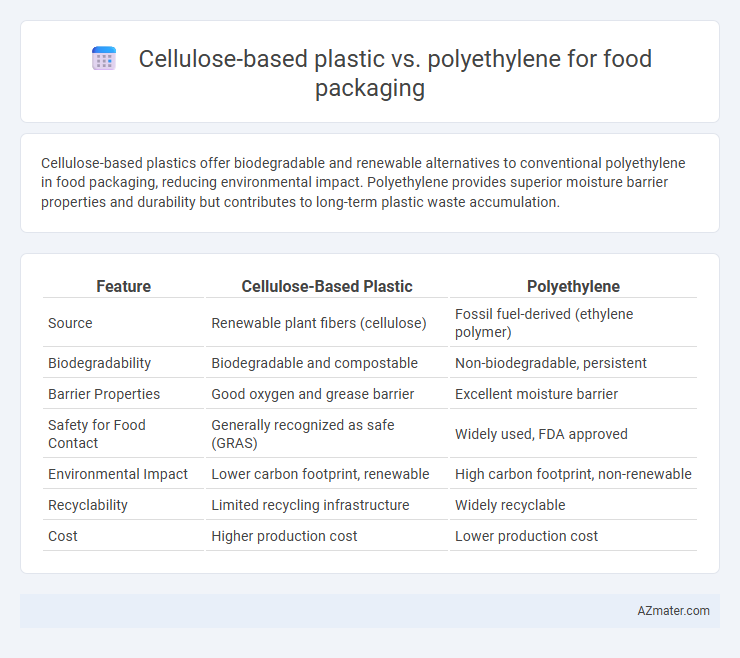Cellulose-based plastics offer biodegradable and renewable alternatives to conventional polyethylene in food packaging, reducing environmental impact. Polyethylene provides superior moisture barrier properties and durability but contributes to long-term plastic waste accumulation.
Table of Comparison
| Feature | Cellulose-Based Plastic | Polyethylene |
|---|---|---|
| Source | Renewable plant fibers (cellulose) | Fossil fuel-derived (ethylene polymer) |
| Biodegradability | Biodegradable and compostable | Non-biodegradable, persistent |
| Barrier Properties | Good oxygen and grease barrier | Excellent moisture barrier |
| Safety for Food Contact | Generally recognized as safe (GRAS) | Widely used, FDA approved |
| Environmental Impact | Lower carbon footprint, renewable | High carbon footprint, non-renewable |
| Recyclability | Limited recycling infrastructure | Widely recyclable |
| Cost | Higher production cost | Lower production cost |
Introduction to Food Packaging Materials
Cellulose-based plastic and polyethylene are prominent materials in food packaging, each offering distinct environmental and functional advantages. Cellulose-based plastics, derived from renewable plant fibers, provide biodegradability and enhanced sustainability compared to conventional polyethylene, which is a petroleum-based polymer known for its durability and moisture barrier properties. The choice between these materials depends on factors such as shelf life requirements, environmental impact, and consumer preferences for eco-friendly packaging solutions.
Overview of Cellulose-based Plastics
Cellulose-based plastics, derived from natural cellulose fibers, offer an eco-friendly alternative to conventional polyethylene in food packaging due to their biodegradability and renewable origin. These bioplastics provide excellent oxygen and moisture barrier properties, enhancing food preservation while reducing environmental impact. Their compatibility with composting systems and lower carbon footprint make cellulose-based plastics a sustainable choice for reducing plastic waste in the food packaging industry.
Understanding Polyethylene in Food Packaging
Polyethylene is a widely used polymer in food packaging due to its excellent moisture barrier properties, flexibility, and chemical resistance, which help preserve food freshness and extend shelf life. Its versatility allows for various forms, including low-density polyethylene (LDPE) and high-density polyethylene (HDPE), each offering specific benefits like enhanced toughness or rigidity. Compared to cellulose-based plastics, polyethylene provides superior durability and scalability in packaging applications, although it presents challenges in biodegradability and environmental impact.
Environmental Impact Comparison
Cellulose-based plastics offer superior environmental benefits over polyethylene in food packaging due to their biodegradability and reduced reliance on fossil fuels, resulting in lower carbon emissions. Polyethylene, derived from petroleum, contributes significantly to plastic pollution and has a longer degradation period in landfills and oceans. The adoption of cellulose materials supports circular economy principles by enabling compostability and minimizing microplastic contamination in ecosystems.
Biodegradability and Compostability
Cellulose-based plastics demonstrate superior biodegradability and compostability compared to polyethylene, breaking down naturally within weeks under industrial composting conditions. Polyethylene, a petroleum-derived polymer, resists microbial degradation and persists in environments for decades, contributing to plastic pollution. Choosing cellulose-based packaging significantly reduces environmental impact by enabling faster organic matter recycling and minimizing landfill waste in food packaging applications.
Food Safety and Chemical Migration
Cellulose-based plastics offer superior food safety due to their natural, biodegradable composition, minimizing the risk of harmful chemical migration compared to polyethylene. Polyethylene, while widely used for its durability and moisture barrier properties, may release additives or residual monomers under certain conditions, posing potential health risks. Optimizing food packaging with cellulose-based materials reduces chemical migration concerns and aligns with safer, eco-friendly standards in food preservation.
Barrier Properties: Moisture and Oxygen Resistance
Cellulose-based plastics offer superior oxygen barrier properties due to their dense hydrogen-bonded polymer network, effectively limiting oxygen transmission rates (OTR), which is critical for preserving food freshness. Polyethylene, particularly low-density polyethylene (LDPE), exhibits excellent moisture resistance with low water vapor transmission rates (WVTR), making it ideal for preventing moisture ingress but has relatively poor oxygen barrier performance. Combining cellulose's oxygen barrier with polyethylene's moisture resistance through multilayer packaging enhances overall protection, extending shelf life in food packaging applications.
Mechanical Strength and Durability
Cellulose-based plastics exhibit moderate mechanical strength suitable for light food packaging but generally lack the tensile strength and impact resistance of polyethylene. Polyethylene offers superior durability, with high flexibility and robust barrier properties against moisture and contaminants, making it ideal for long-term food storage. The biodegradability of cellulose-based plastics contrasts with the extended lifespan and mechanical resilience of polyethylene, influencing their application depending on sustainability goals and product protection requirements.
Cost-effectiveness and Scalability
Cellulose-based plastic offers biodegradability and sustainability benefits but typically incurs higher production costs compared to polyethylene, impacting overall cost-effectiveness in large-scale food packaging. Polyethylene, widely produced through established industrial processes, benefits from economies of scale, making it more cost-effective and scalable for mass food packaging applications. However, growing environmental regulations and consumer demand are driving investments that may improve the scalability and reduce the costs of cellulose-based alternatives over time.
Future Trends in Sustainable Food Packaging
Cellulose-based plastics for food packaging are gaining traction due to their biodegradability, renewable sourcing, and potential to reduce plastic pollution compared to polyethylene. Innovations in cellulose nanofibers and coating technologies enhance barrier properties, making cellulose-based materials competitive with polyethylene in preserving food quality. Future trends emphasize integrating cellulose plastics with circular economy models and developing scalable, cost-effective production methods to meet rising consumer demand for sustainable packaging solutions.

Infographic: Cellulose-based plastic vs Polyethylene for Food packaging
 azmater.com
azmater.com